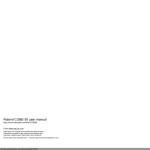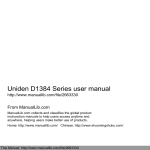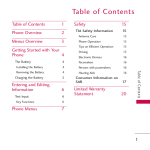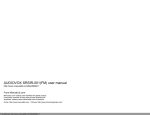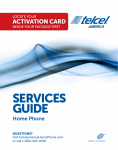Download LG 100C user manual
Transcript
LG 100C user manual http://www.manuallib.com/file/2589282 From ManualLib.com ManualLib.com collects and classifies the global product instrunction manuals to help users access anytime and anywhere, helping users make better use of products. Home: http://www.manuallib.com/ Chinese: http://www.shuomingshuku.com/ This Manual: http://www.manuallib.com/file/2589282 LG100C_TF_Eng_QSG_0709 7/9/09 4:27 PM Page 1 LG 100C Quick Start Guide Installing the Battery To install the battery, insert the battery into the opening on the back of the phone. Put the battery cover on the phone and slide it downwards until it locks into place. Removing the Battery 1. With your phone turned off, push forward from the bottom of the battery cover (1) on the back of your phone, slide the battery cover up and lift off (2). Charging the Battery Phone layout and key functions Your phone is powered by a rechargeable Li-ion battery. Use the wall charger to charge the battery, and use only LG approved batteries and chargers. Note: You must fully charge te battery before using your phone for the first time. A fully discharged battery requires up to 4 hours of charge time. Note: For connection to an electrical supply not located in the U.S., you must use an adapter of the proper configuration for the power outlet. Using the wrong adaptor can damage your phone and void your warranty. 1. Open the cover on the accessory port on the right side of the phone and plug the wall charger connector into the jack. Be sure to orient the connector as shown to avoid damaging your phone. 2. Plug the charger into a standard AC wall outlet. 3. When the phone is completely charged( wall outlet. 2. Lift the battery up (1) and away (2) from the phone, as shown. ), unplug the charger from the Your phone displays the following status indicators on the top of the screen: Icon Description Earpiece Signal strength Ring & Speaker Calendar Headset Jack Airplane Mode 1 Beep Alarm & Calendar Volume keys Battery Strength 1 Beep & Speaker Roaming In Call State Silence All Digital No Service Silence All & Speaker 1X LCD Screen Navigation Keys OK Key Right Soft Key BACK Key Left Soft Key Speakerphone Key SEND Key END/PWR Key Alphanumeric Keypad 4. Remove the charger from the phone by gently pulling out the connector. Replace the plastic cover over the open jack. Important: The battery charging function may stop when you are on a call, to avoid damage to the battery. Do not remove the battery from the phone while charging and make sure the wall charger is disconnected from the phone before removing the battery. Manner Mode Key Microphone • Easy-to-read, 7-line backlight LCD with status icons. • Paging, messaging, voice mail, and caller ID. • Depending on the software installed or your service provider or country, some of the descriptions in this guide may not match your phone exactly. • Depending on your country, your phone and accessories may appear different from the picture in this guide. Alarm Only SSL New Voicemails Alarm & Speaker TTY Msg & Voicemail Vibrate Only Location On Speaker Phone Vibrate & Speaker E911 Only Ring Alarm Active Data until the LCD screen lights up. 3. To turn off, press and hold • Speaker phone feature. until the display turns off. • Menu-driven interface with prompts for easy operation and configuration. Allows you to use the bilingual feature according to your preference. Choose between English and Spanish. 1. To reinstall the battery, align the battery contacts (1) with those in the battery compartment. Press the battery down until it clicks into place (2). • Any key answer, auto answer, auto retry, one-touch and speed dialing with 99 memory locations. 1. In Idle mode, press the Left soft key 2. With the battery in position in the phone, replace the battery cover on the back of your phone. • Bilingual (English and Spanish) capabilities. Please make sure that the 'B' side of the connector is facing up. • Internal Antenna, described as 'antenna' throughout this user guide. Display Your phone is in Idle mode when you are not on a call or using a menu. You must be in idle mode to enter a phone number to dial. 2. Select 3. Use g g Menu to access Main menu. . to select English or Spanish, then press . Making Calls 1. Make sure you are on the Idle mode screen. If the phone is locked, press the Left Soft Key Unlock to unlock. Icons Text and graphics area Soft key function indications 2. Using the keypad, enter the phone number (include the area code if needed). 3. Press to dial. 4. Press to end the call. Note: To view a quick list of all your recent calls, press Key while in standby mode. 1. Missed Calls : Allows you to view the list of missed calls; up to 40 entries. Press Left Soft Key , , g Use to highlight an entry. 2. Received Calls : Allows you to view the list of received calls; up to 40 entries. Press Left Soft Key , , g Use Menu to access Main menu. 1. Press the Left Soft Key 2. Use the Navigation keys to reach a desired menu and then press 3. If the menu contains any submenus, locate the one you want by using the Navigation keys . Press to enter the submenu. If the selected menu contains additional submenus, repeat this step. 3. Dialed Calls : Allows you to view the list of dialed calls; up to 40 entries. Press Left Soft Key , , g Use to highlight an entry. 4. All Calls : Allows you to view the list of the most recent missed, received and dialed calls; up to 120 entries. , , g The history of all calls are displayed. to highlight one of the call Sound Options to customize your phone's sounds: Ringers 1. Press the Left Soft Key Menu, Settings, Sounds, and then Ringers. 2. Select All Calls/ Caller ID/ No Caller ID/ Restricted Calls/ Buy Ringtones. 3. Select My Audios/ Default. 4. Use to highlight the ringtone. 5. Press Play to play the ringtone, and Set to set the ringtone to your phone. 6. Press Buy Ringtones to purchase ringtones. Volume 1. Press the Left Soft Key Volume. Menu, Settings, Sounds, and then 2. Select Master Volume/ Keypad/ Earpiece/ Speaker. 3. Use This Manual: http://www.manuallib.com/file/2589282 Selecting or Modifying a Menu or Feature : to highlight an entry. , , g Use Press Left Soft Key types (below). Last Call/ Home Calls/ Roam Calls/ All Calls 1. To turn on, install a charged battery. 2. Then press The Recent Calls Menu is a list of the last phone numbers or Contacts entries for calls missed, received, or dialed. It is continually updated as new numbers are added to the beginning of the list and the oldest entries are removed from the bottom of the list. Press Left Soft Key Turning the Phone On and Off Using the menus 5. Call Timer : Allows you to view the duration of the different types of calls. Changing the display language • 23-key keypad. Replacing the Battery New Message Recent Calls to adjust the volume of the function, then press to save the setting. Menu map 1. Prepaid 4. Recent Calls 8. Tools 1.1 Add Airtime 1.2 Buy Airtime 1.3 My Phone Number 1.4 Airtime Info 1.5 Airtime Display 1.6 Serial Number 1.7 Code Entry Mode 4.1 Missed Calls 4.2 Received Calls 4.3 Dialed Calls 4.4 All Calls 4.5 Call Timer 8.1 Voice Command 8.2 Ez Tip Calc 8.3 Calculator 8.4 World Clock 8.5 Stopwatch 8.6 Unit Converter 2. Contacts 2.1 New Contact 2.2 Contact List 2.3 Groups 2.4 Speed Dials 3. Messages 3.1 New Message 3.2 Inbox 3.3 Sent 3.4 Drafts 3.5 Voicemail 3.6 Templates 3.7 Msg Settings 3.8 Delete All 5. My Folder 5.1 Record Voice 5.2 Images 5.3 Audios 6. Browser 6.1 Start Browser 6.2 Web Messages 7. My Schedule 7.1 Alarm Clock 7.2 Calendar 7.3 Notepad 9. Settings 9.1 Sound 9.2 Display 9.3 Keyguard Timer 9.4 Security 9.5 Call Settings 9.6 System 9.7 Phone Memory 9.8 Phone Info . LG100C_TF_Eng_QSG_0709 7/9/09 4:27 PM Page 8 Entering text Quick feature reference In a text input field, press the key to toggle between capitalization modes. To switch between T9word mode, 123 and ABC mode, press the Left Soft Key and select Symbols. Using T9word mode This section provides instructions on how to access the different features on your phone. Menu Description , , 1. Use the 2 to 9 keys to start entering a word. Press each key once for one letter. Add Airtime allows you to start an over-the-air request for additional airtime. , , The word you are entering appears on the display. Options may change with each keypress. Buy Airtime allows you to start an over-the-air request for purchase additional airtime. , , My Phone Number displays the phone's phone number. , , Airtime Info displays the airtime balance and due date information. Using ABC mode , , Airtime Display allows you to disable/enable the display of Balance and Due Date info on the idle screen. Press the keys labeled with the letter you want once for the first letter, twice for the second letter, and so on. , , Serial Number simply displays the phone's serial number. , , Code Entry Mode will allow the phone to accept Tracfone-related codes in order to add units, modify specific data and troubleshoot the phone. In using the Code Entry Mode, you can't receive incoming calls or use events alert. For example: To enter “Hello” in T9Word mode, press 4, 3, 5, 5, and 6. 2. Press to insert a space and enter the next word. For example, press 2 three times to enter “C” and 5 two times to enter “K”. Using 123 mode Press the keys that correspond with the digits you want to enter. Using Symbols mode Press the keys that correspond with the symbol you want to enter and press You can press or to display more symbols. . Tips for entering text • To move the cursor, press the • To insert a space between characters, press , , Contact List you to view your saved contacts. , , You can send text messages and e-mail transmissions. New Message. © 2009 LG Electronics, Inc. to access the Text Entry screen. 4. Type your message (text or e-mail). 5. Press Send. A confirmation message is displayed. This Manual: http://www.manuallib.com/file/2589282 Speed Dials allows you to view your Speed Dials list, designate new Speed Dials, or remove Speed Dial designations entered in your Contacts. , . New Message allows you to send text messages and e-mail transmissions. , , Inbox allows you to view your received messages. , , Sent allows you to view your sent messages. Up to 50 sent messages can be stored in the Sent folder. Access to view contents of sent messages and verify whether the transmission was successful or not. , , Drafts allows you to view the saved (message) Drafts. , , Voicemail allows you to view how many new voicemails you have and to access your voicemail box. , , Templates allows you to display, edit, and add text phrases. These text strings allow you to reduce manual text input into messages. , , Msg Settings allows you to configure settings for Messaging. , , Delete All you to erase the messages stored in your Inbox, Sent, or Drafts message folders. You can also erase all messages at the same time. 2. Enter the recipient's address. 3. Press Groups allows you to view your grouped Contacts, add a new group, change the name of a group, or delete a whole group. , , Sending an SMS message and New Contact allows you to add a new contact to your Contact List: . • To enter punctuation in T9Word mode or ABC mode, press Menu, , . To delete all of the characters, press • To change capitalization mode in T9Word mode or ABC mode, press and hold . 1. Press , , . • To delete characters one by one, press and hold . *Many of the features and services described are network dependent and may require additional subscription and/or usage charges. Not all features are available for purchase or use in all areas. Other conditions and restrictions may apply. See carrier for more information. TIA Safety Information Menu Description , , Missed Calls allows you to view the list of missed calls; up to 40 entries. , , Received Calls allows you to view the list of received calls; up to 40 entries. , , Dialed Calls allows you to view the list of dialed calls; up to 40 entries. , , All Calls allows you to view the list of missed, received and dialed calls; up to 120 entries. , , Call Timer allows you to view the duration of calls by call type. , , Record Voice allows you to record short verbal/voice messages. , , Images allows you to view your saved images, some of which can be set as your phone's Main Screen or Picture ID. , , Audios allows you to access saved audio clips and record new ones. , , Start Browser starts the Web Browser; this allows you to view Internet content. , , Web Messages allows you to view Web messages. , , Alarm Clock allows you to set up to five alarms. At the alarm time, any set alarm will sound (depending on your Master Volume settings) the tone of your choice, and an alarm message will be displayed on the LCD screen. , , , Notepad allows you to add, read, edit, and erase notes. , , Voice Command allows you to access the Voice Command menu. Voice Command allows you to access several features using voice prompts, this menu can useful for those who are driving or who may be blind. , , Description , Ez Tip Calc allows you to quickly and easily estimate the tip and total amount of a bill by inputting the bill amount before tip, the tip percentage, and dividing it by the number of people paying. , , Calculator allows you to perform simple mathematical calculations. , , World Clock allows you to determine the current time in another time zone or city. , , Stopwatch allows you to use your phone as a stopwatch. , , Unit Converter allows you to convert units of Area, Length, Temperature, Mass, Volume and Velocity. Options to customize your phone's sounds: 1.1 Ringers 1.2 Volume 1.3 Message Alerts 1.4 Alert Type 1.5 Service Alerts 1.5.1 Minute Beep 1.5.2 Call Connect 1.5.3 Back to Top 1.5.4 Low Battery 1.6 Power On/ Off Tone , , Options to customize your phone's display. 2.1 Wallpaper 2.2 Banner 2.3 Backlight 2.4 Menu Style 2.5 Languages 2.6 Clocks & Calendar 2.7 Font Settings , , Options to customize your phone's Keyguard Timer 1. Select between 7 Seconds/15 Seconds/ 2 Minutes/Always Off , , , , Calendar allows you to access your Calendar appointments. Simply enter your appointments in the Calendar, and your phone can alert you with a reminder. , , Menu , , The Security menu allows you to secure the phone. To access this menu, you will need the Lock Code. Usually, it is the last 4 digits of your phone number. 4.1 Lock Phone 4.2 Restrictions 4.3 Change Lock Code 4.4 Reset Default The Call Settings menu allows you to designate how the phone handles both incoming and outgoing calls. 5.1 Answer Options 5.2 Auto Retry 5.3 One-Touch Dial 5.4 Voice Privacy 5.5 Voice Clarity 5.6 Airplane Mode 5.7 TTY Mode The System menu allows you to designate specific system network settings. 6.1 Network 6.1.1 System Select 6.1.2 Serving System 6.2 Location , , Allows you to check out the memory status of your phone. , , The Phone Info menu provides you with specific information pertaining to your phone model. The following is the complete TIA Safety Information for wireless handheld phones. Antenna Care Use only the supplied or an approved replacement antenna. Unauthorized antennas, modifications, or attachments could damage the phone and may violate FCC regulations. Phone Operation NORMAL POSITION: Hold the phone as you would any other telephone with the antenna pointed up and over your shoulder. Tips on Efficient Operation For your phone to operate most efficiently: Don’t touch the antenna unnecessarily when the phone is in use. Contact with the antenna affects call quality and may cause the phone to operate at a higher power level than otherwise needed. Driving Check the laws and regulations on the use of wireless phones in the areas where you drive and always obey them. Also, if using your phone while driving, please observe the following: Give full attention to driving -- driving safely is your first responsibility; Use hands-free operation, if available; Pull off the road and park before making or answering a call if driving conditions or the law require it. ● ● ● Electronic Devices Most modern electronic equipment is shielded from RF signals. However, certain electronic equipment may not be shielded against the RF signals from your wireless phone. Pacemakers The Health Industry Manufacturers Association recommends that a minimum separation of six (6) inches be maintained between a handheld wireless phone and a pacemaker to avoid potential interference with the pacemaker. These recommendations are consistent with the independent research by and recommendations of Wireless Technology Research. Persons with pacemakers: ● ● ● ● Should ALWAYS keep the phone more than six (6) inches from their pacemaker when the phone is turned ON; Should not carry the phone in a breast pocket; Should use the ear opposite the pacemaker to minimize the potential for interference; Should turn the phone OFF immediately if there is any reason to suspect that interference is taking place. Hearing Aids Some digital wireless phones may interfere with some hearing aids. In the event of such interference, you may want to consult your service provider (or call the customer service line to discuss alternatives). Consumer Information on SAR This Model Phone Meets the Government’s Requirements for Exposure to Radio Waves. Your wireless phone is a radio transmitter and receiver. It is designed and manufactured not to exceed the emission limits for exposure to Radio Frequency (RF) energy set by the Federal Communications Commission of the U.S. Government. These limits are part of comprehensive guidelines and establish permitted levels of RF energy for the general population. The guidelines are based on standards that were developed by independent scientific organizations through periodic and thorough evaluation of scientific studies. The standards include a substantial safety margin designed to assure the safety of all persons, regardless of age and health. The exposure standard for wireless mobile phones employs a unit of measurement known as the Specific Absorption Rate, or SAR. The SAR limit set by the FCC is 1.6 W/kg. Tests for SAR are conducted using standard operating positions specified by the FCC with the phone transmitting at its highest certified power level in all tested frequency bands. Although SAR is determined at the highest certified power level, the actual SAR level of the phone while operating can be well below the maximum value. Because the phone is designed to operate at multiple power levels to use only the power required to reach the network, in general, the closer you are to a wireless base station antenna, the lower the power output. Before a phone model is available for sale to the public, it must be tested and certified to the FCC that it does not exceed the limit established by the government-adopted requirement for safe exposure. The tests are performed in positions and locations (e.g., at the ear and worn on the body) as required by the FCC for each model. The highest SAR value for this model phone when tested for use at the ear is 1.3 W/kg and when worn on the body, as described in this user guide, is 0.886 W/kg (body-worn measurements differ among phone models, depending upon available accessories and FCC requirements). While there may be differences between SAR levels of various phones and at various positions, they all meet the government requirement for safe exposure. The FCC has granted an Equipment Authorization for this model phone with all reported SAR levels evaluated as in compliance with the FCC RF emission guidelines. SAR information on this model phone is on file with the FCC and can be found under the Display Grant section of http://www.fcc.gov/oet/fccid after searching on FCC ID BEJLG200CM. Additional information on Specific Absorption Rates (SAR) can be found on the Cellular Telecommunications Industry Association (CTIA) website at http://www.ctia.org. * In the United States and Canada, the SAR limit for mobile phones used by the public is 1.6 watts/kg (W/kg) averaged over one gram of tissue. The standard incorporates a substantial margin of safety to give additional protection for the public and to account for any variations in measurements.




